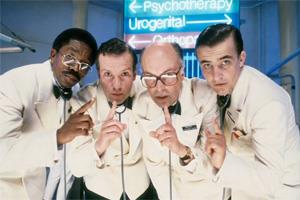[Editor's note: On occasion, we invite a former college student to write a guest column about a TV show, new or old, that resonates with him or her, and provides us insight from their younger perspective. Here's the latest occasion, from one of my best recent students, Ray Saker. - DB]
This month saw the end of The Leftovers, making the bold choice of closing its three-season tenure on HBO with a point-of-view episode, resolving the series’ driving life-after-disappearance mystery by way of a dubious monologue. Nora, a central character played by Carrie Coon, told a long story about what happened to her when she traveled to the "other side" -- but should we believe her?
This made sense, and was almost an obvious choice, as the series’ most pivotal episodes have taken a single character’s perspective, and some of the most compelling stories in The Leftovers, over the seasons, were told but not shown.
As for the veracity of Nora’s story, that’s ultimately for the audience to decide. But if we look at the stories that the characters have told us in the past - like the legend of Frasier the lion - they’ve been true, if anything. And much of The Leftovers is all about faith, of one sort or another, so why not believe?
But these weren’t the only bold choices The Leftovers made. As the narrative structure of the series evolved and developed to get to that point, so did its style, both visually and narratively. The Leftovers’ artistic development happened in tune with the television landscape as it's evolved on a broader scale. We've seen greater artistic influence take root across the television dial - broadcast TV had such series as NBC's Hannibal, cable networks had such shows as USA's Mr. Robot (right), and premium channels like HBO The Leftovers. This is just a sample, but each of these series introduced a new degree of art to the platform, innovating it episode by episode.
One of the bigger surprises in terms of the recent when and the where was Hannibal (below left), seemingly leading the charge in 2013, on NBC, in one of the last places you’d expect to find a series breaking ground these days. There’s no mistaking that Hannibal was quality television, with acting and writing that could rival even its Silence of the Lambs and Manhunter source material.
What really set it apart was its cinematography. We’d seen Hollywood talent step into TV on both sides of the camera on modern classics, including The Sopranos and Breaking Bad, but Hannibal was the series that, in my opinion, finally introduced the word “cinematography” into the television lexicon. Hannibal also showcased, alongside its artful depiction of physical gore, an equally artful depiction of psychological gore.
We watch Will Graham’s steep descent into madness wrinkle the fabric of the narrative itself. He starts to question what he is seeing as we start to question what we are seeing. Hannibal creator Bryan Fuller masterfully synchronizes the protagonist’s perspective with the audience’s, making for a wonderful series of backtracks, sidesteps, and pump fakes, made even more astounding when you remember that it’s on broadcast television -- an environment that, with very few exceptions, hasn’t been known for innovation in at least a decade.
Also on the topic of innovation, 2015 saw the USA Network take a step outside of its pop-TV formula to take a risk with Sam Esmail’s now-iconic Mr. Robot. Like Hannibal, Mr. Robot has a distinct visual style, but it took a more experimental route - full of canted, asymmetrical angles packed with style and symbolism.

But what Mr. Robot really added to the mix was a postmodern, extremely focused narrative, reminiscent of, and really only comparable to, the British cult classic The Singing Detective (right). The Mr. Robot audience, along with protagonist Elliot, has vital information locked away behind a wall of mental illness and trauma, and we have to follow along blindly as he cuts a swath toward reality. The series puts us in the shoes of a narrator who can’t trust himself, and somewhere in the space between psychosis and omniscience comes to acknowledge his audience, then grapples with how much he can trust them. This narrative structure creates a fog of uncertainty, which brings a unique suspense -- and also an uneasy sense of understanding.
Between the premieres of Hannibal and Mr. Robot was the beginning of The Leftovers, a brooding series about brooding people, which found its place as a series about people finding their place.
Thematically, The Leftovers stands alone, with both feet planted on a platform of magical realism. The series never shies away from the surreal, at times even edging on absurdist territory, taking us from Kevin Garvey’s crusade against a local cult to his crossing the River Styx.
But the often outlandish external struggles are always reflective on the characters’ personal struggles, which rarely make it to the surface in their traumatized world. That’s what’s so clever about Damon Lindelof’s storytelling in The Leftovers (left) - the characters’ inner demons are rarely addressed openly, but rather exorcised by way of the events around them. The series uses its surreal tone as an exaggerated expression of an essential truth: that we shape the world the same way the world shapes us.
Over the past five years, series such as these have been regularly cropping up, approaching the medium in fundamentally different ways than most of their predecessors. The same way the series a few years before them drastically elevated the production value of the television drama, this latest wave has brought a new degree of artistic influence and made experimentation more commonplace.
At the rate things are going, we have reason to expect some very interesting television moving forward.
--
Ray Saker is a Rowan University graduate and an aspiring television critic, who firmly believes that binge-watching is overrated and Oz is underrated.